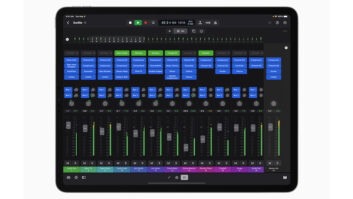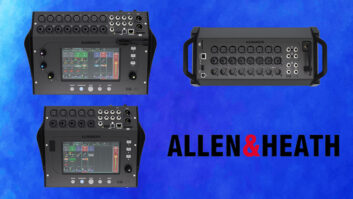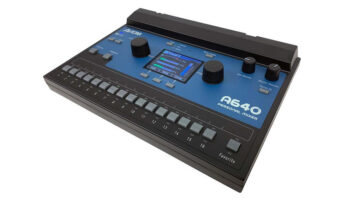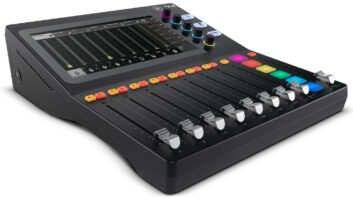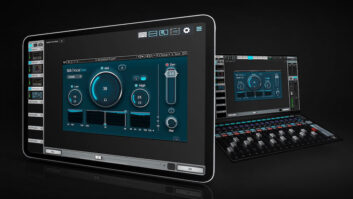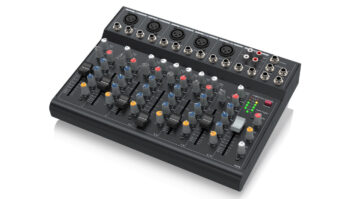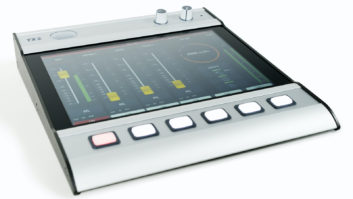Behringer’s iX1642USB mixerSince its introduction two years ago, Apple’s iPad has had a swift impact on the pro audio industry. While aimed squarely at mainstream consumers, the tablet computer has been both adopted and adapted by pro audio manufacturers in surprising ways. The first wave of iPad adoption saw the industry create apps about products, while a second wave found companies as varied as Yamaha, PreSonus, Crown, Allen & Heath and AKG adapt the tablet as a remote controller for gear. This year’s Winter NAMM brought with it a new, third wave, however, with the introduction of compact mixers that physically integrate with the iPad via internal docks.

No less than three companies are pursuing this format, as Mackie, Behringer and Alto Professional each used the convention to bow a total of six compact mixers between them that utilize iPads in a variety of ways. Underlining Apple and the iPad’s sudden influence over the market segment, even Line 6’s new StageScape M20d, a small mixer based around a proprietary touchscreen, still offers iPad remote control and was casually described at NAMM as “Garageband for gigs.”
The compact mixer market has always been ultracompetitive, aiming as it does for small installs, houses of worship, clubs, bands, schools and the like; it’s about as close as consoles get to entering the world of mainstream consumer electronics. The catch is that products have to be priced like consumer electronics as well, which means aggressive price points balanced against lots of features. Given the ubiquity of the iPad (55 million sold to date, over 15 million of those in the last quarter alone), the power of the iPad 2’s 1 GHz dual-core A5 chip, its relatively compact size (9.5 x 7.3 inches), and the potential halo effect of being associated with a popular tech toy, one could understand manufacturers’ desire to integrate the popular tablet into a mixer. While the additional features offered through iPads represents a cost savings to manufacturers, and familiar and efficient new control capabilities for the user, the mixer purchase prices do not include the iPad itself, the manufacturers figuring that consumers already own iPads or wouldn’t mind an excuse to buy one.
Mackie’s DL-1608 mixerProduct manager Ben Olswang explained the genesis of Mackie’s upcoming DL1608, which won a ProSoundNetwork.com Best of Show award at NAMM: “The goal was to deliver a 16-channel digital mixer with a superior user interface…We tried using traditional user interfaces, but that simply drove the cost up to an unacceptable place. When the iPad was launched and quickly became a large part of both our personal and professional lives, we realized that it could deliver a superior, touchsensitive, wireless-capable user interface that would allow us to deliver a 16-channel digital mixer to the user for $999 street.” The DL1608 sports 16 Onyx mic preamps; 24-bit Cirrus Logic AD/DA converters, 12 XLR and four combo mic/line inputs, internal DSP and more, as well as the ability to bring in stereo audio from any app without using one of the mixer’s 16 channels.

Alto Professional (which was unavailable for comment at press time) announced its own pair of iPadintegrating mixers at NAMM: the Masterlink Live 16 and 24. Each will offer channel compression, 3-band semi-parametric EQ, four aux sends, four group busses and built-in Alesis digital effects, as well as 16 and 24 inputs, respectively. Mix analysis, processing and recording will be handled within the iPad with the company’s Live Drive app
Alto Professional’s Masterlink Live 24 mixerAt the NAMM show, Behringer used the convention to debut its three iPad-ready 16-, 24- and 32-input Xenyx iX mixers, each of which will be a 4/2-bus mixer with iPad docking station, Xenyx mic preamps and compressors, Klark Teknik multi-FX processor and more. Costa Lakoumentas, Behringer’s senior vicepresident of marketing, explained, “Rather than reinvent the wheel in processing, we focused on control. The strong suit of the iPad is its user interface, so we tapped into that element to offer deep control over our extensive effects engine. iX mixers offer sophisticated features such as full parametric and graphic EQ, a full 9-parameter control over each effect and the ability to completely customize effects and then save them for later retrieval in performance.”

With three manufacturers about to compete in this sudden, instant product category, they each take different approaches to the concept of how best to use the iPad with a compact mixer. Behringer’s processing will be tackled within the mixer, said Lakoumentas, adding, “Because we use the iPad for control rather than processing, we avoid the latency issues confounding other manufacturers.”
Mackie, on the other hand, chose to handle processing within the iPad, as Olswang explained: “There are certainly other mixers out there with some level of iPad control, but… they either stick to the old paradigm, using traditional hardware like faders and v-pots, or they have an integrated touch screen in their mixer. In both cases, this drives up the cost of the mixer.”
Regardless of how the iPad is integrated, product development isn’t necessarily any faster due to the presence of a completed tablet, as both Mackie and Behringer noted. “Overall development time is similar; there is still significant software and firmware development like any other digital mixer,” remarked Olswang at Mackie. Behringer’s Lakoumentas added, “Software development has two distinct components to it: the GUI and the underlying code. The Apple iOS SDK helps considerably on both counts, allowing developers to tap into modules that greatly accelerate development time. However, it all starts with great design and a clear definition of purpose. If all of those elements are in place and the beta test team are properly motivated, then time to market can be greatly improved using Apple’s tools.”
One aspect that could affect any iPad-integrating mixer is Apple itself. The computer company is notoriously secretive about products in the pipeline, and the iPad already changed dimensions just between the original edition and the iPad 2. As a result, ensuring that their mixers are future-proof in terms of integrating physical docks with Apple’s evolving hardware is a priority for all these companies. Both Mackie and Behringer noted that their respective mixers will accommodate changing form factors, and do not have modelspecific docks.
And what of the evolving iPad itself? At press time, Apple is strongly expected to announce the iPad 3 in March. As is always the case with an Apple product, rumors as to the unit’s capabilities vary but there’s some consensus the iPad 3 will have an A6 chip and the same form factor as the 2, although some predict it could be 1 mm thicker due to the widely speculated addition of an IGZO screen from Sharp.
What effect the introduction of these mixers might have on higherend consoles—if any—remains to be seen, but one question that doesn’t require guessing is whether we’ll see more iPad-integrating compact mixers in the future. “We will always look for better ways to serve our customers and that includes delivering more products that use iOS devices to deliver more features and better value,” remarked Behringer’s Lakoumentas.
Olswang at Mackie noted, “The iPad is a tremendous way to control a mixer, and we plan to bring this concept to market in designs with different channel counts and additional form factors in the future. Customers have already embraced the iPad in their everyday lives, and it will be no different in the Pro Audio world.”
Alto Professional
Altoproaudio.com
Behringer
behringer.com
Line 6
Line6.com
Mackie
mackie.com
